I’m Lyndsay, mother, creative and storyteller with a background in interiors PR. Story & Thread. is a weekly letter exploring the intersection of creativity, mothering and the living world, with a home and a garden at the heart...
Please feel free to share parts of this newsletter that connect with you — here on Substack, on social media or I would love you to send it on to someone special to you.
“My heart is a garden tired with autumn,
Heaped with bending asters and dahlias heavy and dark”
— Sara Teasdale, The Garden, Flame & Shadow, 1920.
Hi everyone
We are edging ever closer to winter and the view into our garden is changing from the aged, earthy autumnal hues towards a more pared back, muted palette punctuated with bare branches that have a sparse scattering of remaining leaves.
I have mentioned before, that this autumn I have left the garden mainly to its own devices and it has felt good to sense into the wildness of this patch of land. It has been a joy to write this letter, a return to the garden in my mind — it has led me from the desert beauty of Mexico, to the court of Queen Victoria and a historic flower festival via a tapestry of botanical drawings and the meeting of art, symbolism and nature.
In the summer, I had a ‘head full of flowers’ and was craving afternoons being surrounded by flowers. This vision unexpectedly came into being in autumn when we discovered the dahlia flower cutting patch…
Dahlia dreams.
Dahlias come to the fore in autumn, heralding the season of soul and bringing with them an antiqued patina and jewel-like quality.
I find myself being drawn to dahlias with petals in antique shades like ripening apricot, peach and plum, to jewel-like tones of cherry and pomegranate, as deep as blackberry; softened with a dollop of creamy hues.
I have found myself returning to the cutting patch again and again this autumn, both in real life and in my dreams. It is a place where the little ones can roam free amongst the flowers and where I can revel in collecting the jewelled stems one by one, placing them in a basket, ready to bring a flavour of the season into our home.
In the details.
I was astounded by the variety of floral forms at the cutting patch, from tightly packed petals arranged into neat mandalas to large wild blooms, spilling open like stars.
Whilst there are 42 species of dahlia, there are over 57,000 different varieties registered with the Royal Horticultural Society. I was amazed by the variety of forms of dahlias I came across — the RHS classifies dahlia flowers into 14 groups, depending on their shape, including — Formal Decorative Dahlias, Waterlily Dahlias, Pompon Dahlias and Ball Dahlias. Dahlias belong to the Asteraceae family, a name derived from the Greek for ‘star’ and the same family as sunflowers, chrysanthemums, daisies and asters.
Useful and beautiful.
Despite only being introduced here in Britain in the late 18th century, the dahlia has been a flower rich in symbolism and mythology for millennia. It is native to the high lands of Mexico and although it has only been the country’s national flower since 1963, it has long been a source of nutrition, medicine, ornamental beauty, and even as part of the infrastructure.
The dahlia’s name in Nahuatl, the language spoken by the Aztec people, is acocoxochitl, meaning ‘water pipe flower’, as they used hollow Dahlia imperialis stems to transport water.
According to one study, the dahlia was once an important root crop and medicinal plant in central Mexico, Yucatan and Guatemala. Its roots were valued both for the nutritious inulin stored inside them (used to regulate the metabolism of glucose, used to treat diabetes before the discovery of insulin in 1923) and for the antibiotic elements found within the tuber.
Flower medicine.
The flower itself too is believed to have medicinal properties — for thousands of years dahlia petals have been used to make poultices to treat insect stings, sunburn and sores. The healing properties of the flower have been harnessed by a number of today’s skincare brands, none more so than Dear Dahlia, a luxury vegan beauty brand inspired by the dahlia as a symbol of grace and beauty, with every product infused with Dahlia Variabilis flower extract with proven skin-conditioning properties, offering long-lasting protection and natural glow. Dahlia flower essence in its purest form is said to have benefits including stress relief, self-worth and self-empowerment. At home, you can create a floral foot soak by boiling leftover dahlia petals — something I will certainly be trying next year…!
A queenly obsession.
The dahlia obsession reached dizzying heights in Britain in the 1840s — having been brought over from Mexico, dahlias first arrived in Britain in 1798 and were named after the Swedish botanist Anders Dahl.
It became the favourite flower in the court of Queen Victoria — her garden at lavish country home Osborne House was filled with cannas and dahlias and naturally there is a variety of dahlia named after her. In the Victorian Era, when floriography (the language of flowers) was extremely popular, dahlias were given as symbols of devotion, love, beauty and dignity. Similar to the benefits associated its flower essence, dahlias are also tied to steadfastness and inner strength, due to their ability to bloom in autumn, when many other flowers have faded.
Restoration, revival and a resurgence.
A combination of the creation of Christopher Lloyd's Exotic Garden at Great Dixter in the mid-1990s, the relocation of the National Dahlia Collection to the Kehelland Trust in Cornwall and the restoration of many dahlia gardens and borders by the National Trust have contributed to a modern resurgence in dahlia appreciation.
A long-forgotten Victorian tradition, the Stonehenge dahlia show was revived this autumn for the first time in 180 years. Just after the autumn equinox, 29th September - 1st October 2023, five thousand dahlias in a lustrous palette were brought in to adorn the landscape of the Salisbury Plain. This year’s festival paid homage to the historic flower show with floral sculptures fashioned by local growers, flower arranging clubs and professional florists at the neolithic site.
Embodying floral art.
Whilst the dahlia has fallen in and out of fashion over the years, it appears often in art world and is closely associated with celebrated Mexican artist, Frida Kahlo. Flowers were a part of Kahlo — the garden of her home, Casa Azul, was filled with an array of Mexico’s native flora, including cacti, yucca, canna-lily, salvias, marigolds and dahlias. She not only grew and drew flowers with deep symbolic meaning in her art, she also adorned herself in them, with dahlias featuring again and again.
It is noted in sketches and letters, that Kahlo brought in vivid cut flowers to enliven the house. In an unpublished memoir of Emmy Lou Packard, a young American artist who lived at Casa Azul for a time, she spoke of Kahlo’s dining-room table being decorated with bouquets of marigolds, blue and white irises, red zinnias, dahlias, calla lilies, blood-red coxcomb, blue bachelor buttons and violets.
I love the thought of Frida collecting native flowers from her garden, bringing them into her home and adorning herself with them as she embodied her natural landscape. Dahlias from the flower patch have brought much joy to our home this autumn and I feel an appreciation for the flower reaching me at this point in my life. As a later flowering bloom there is a fullness, a spilling over, a radiance and resplendence that is exuded in the lower autumn light that feels enriching to me. Whilst the lighter, brighter summer blooms fall away, the depth of the dahlia’s enduring, timeless tones emerge.
And as we shift towards a quieter winter world, I am still dreaming of dahlias and the times I spent in the flower patch looking for jewels on autumn afternoons…
I’d love to hear if you are a dahlia devotee, or what flower says autumn to you…
Thank you as always for reading and I really look forward to hearing your thoughts.




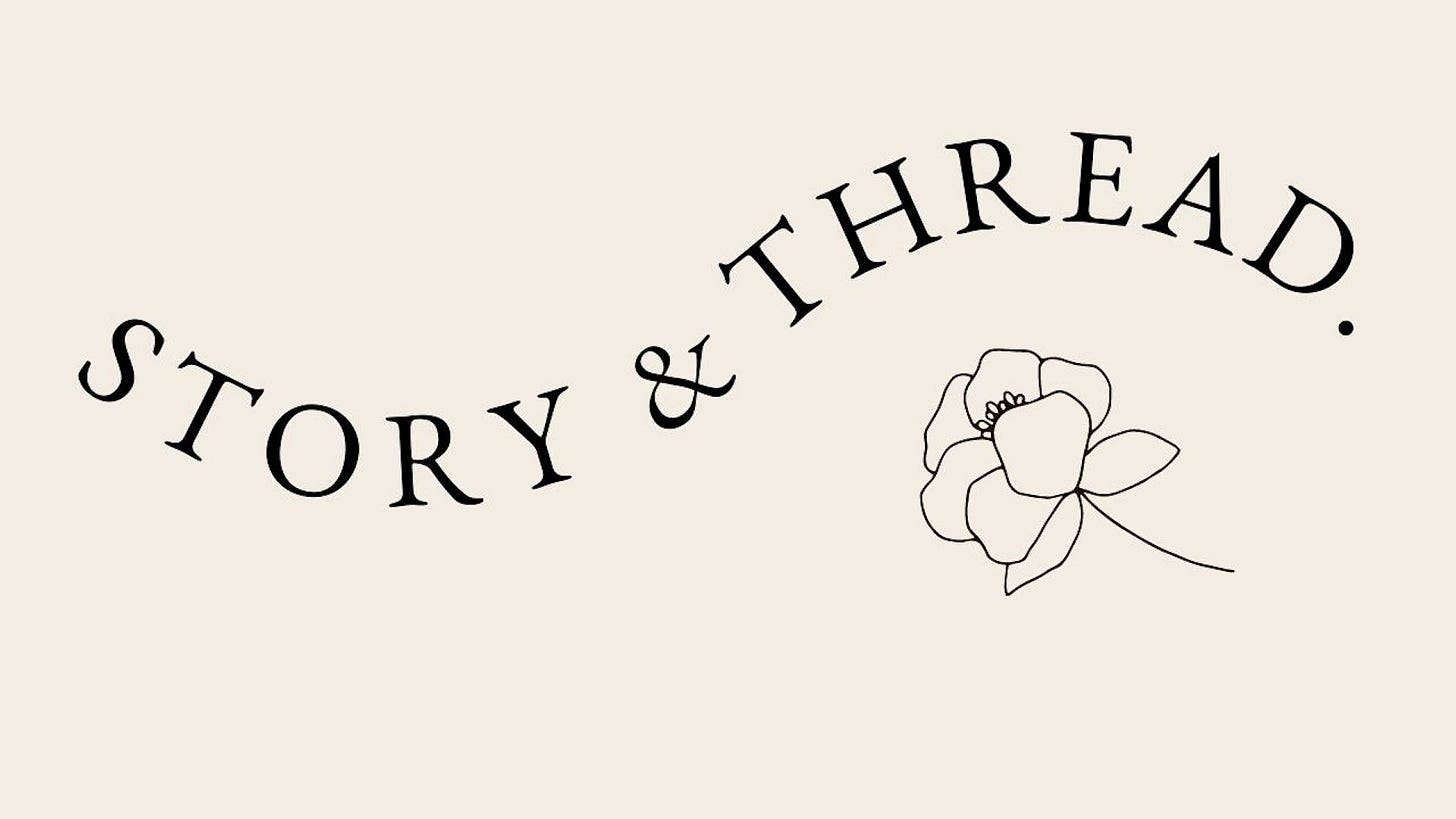
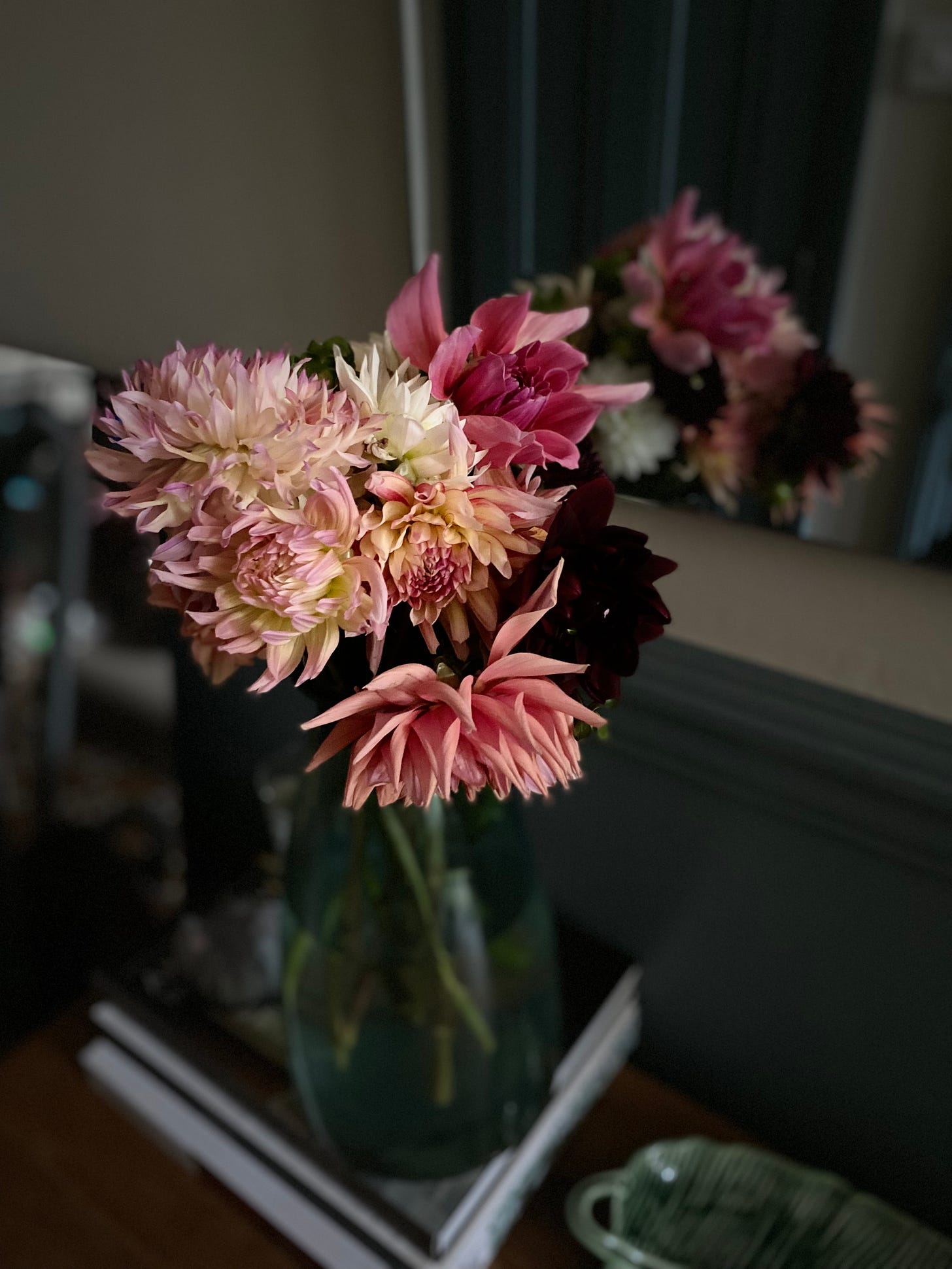
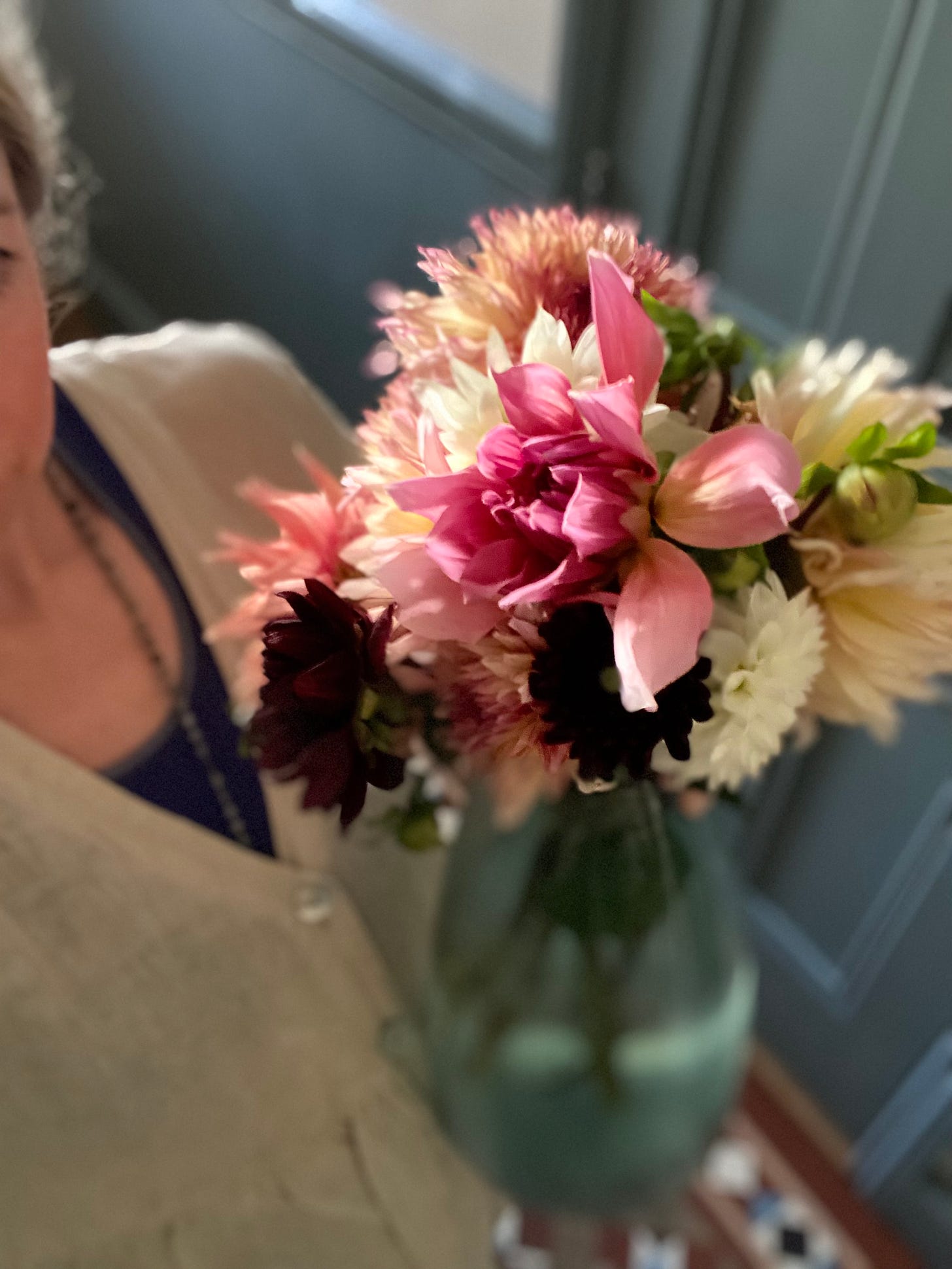
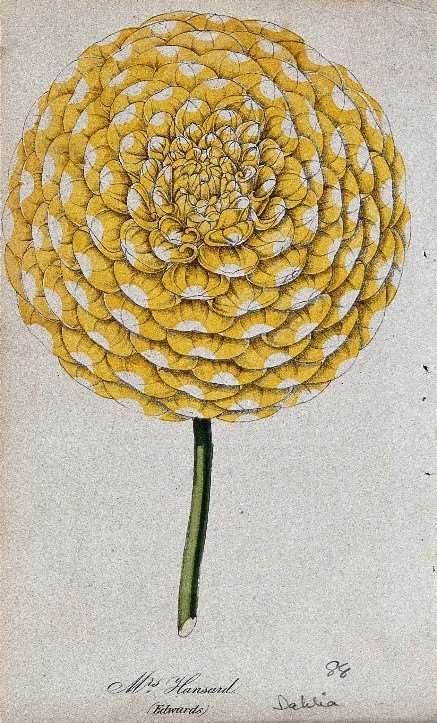
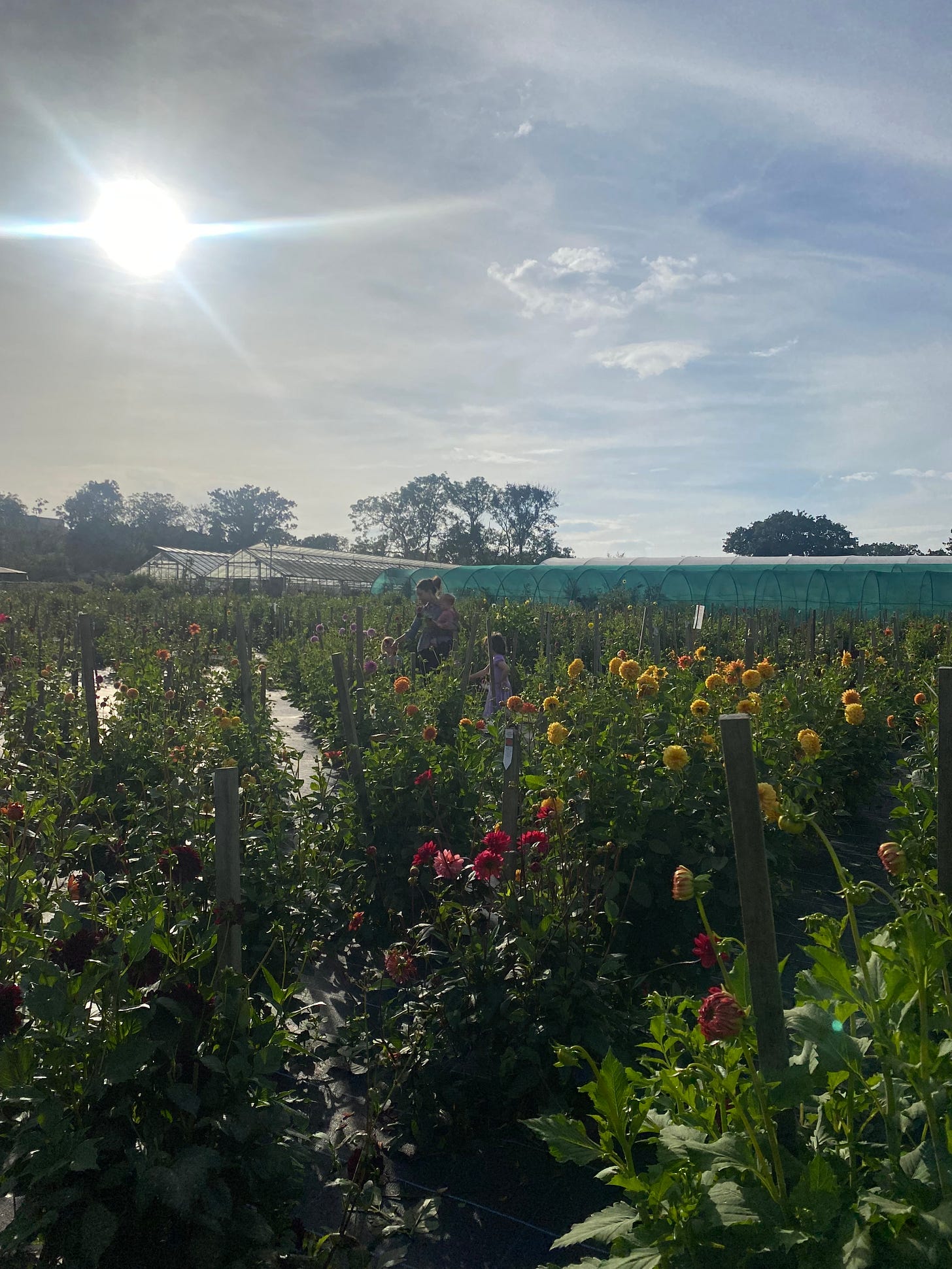
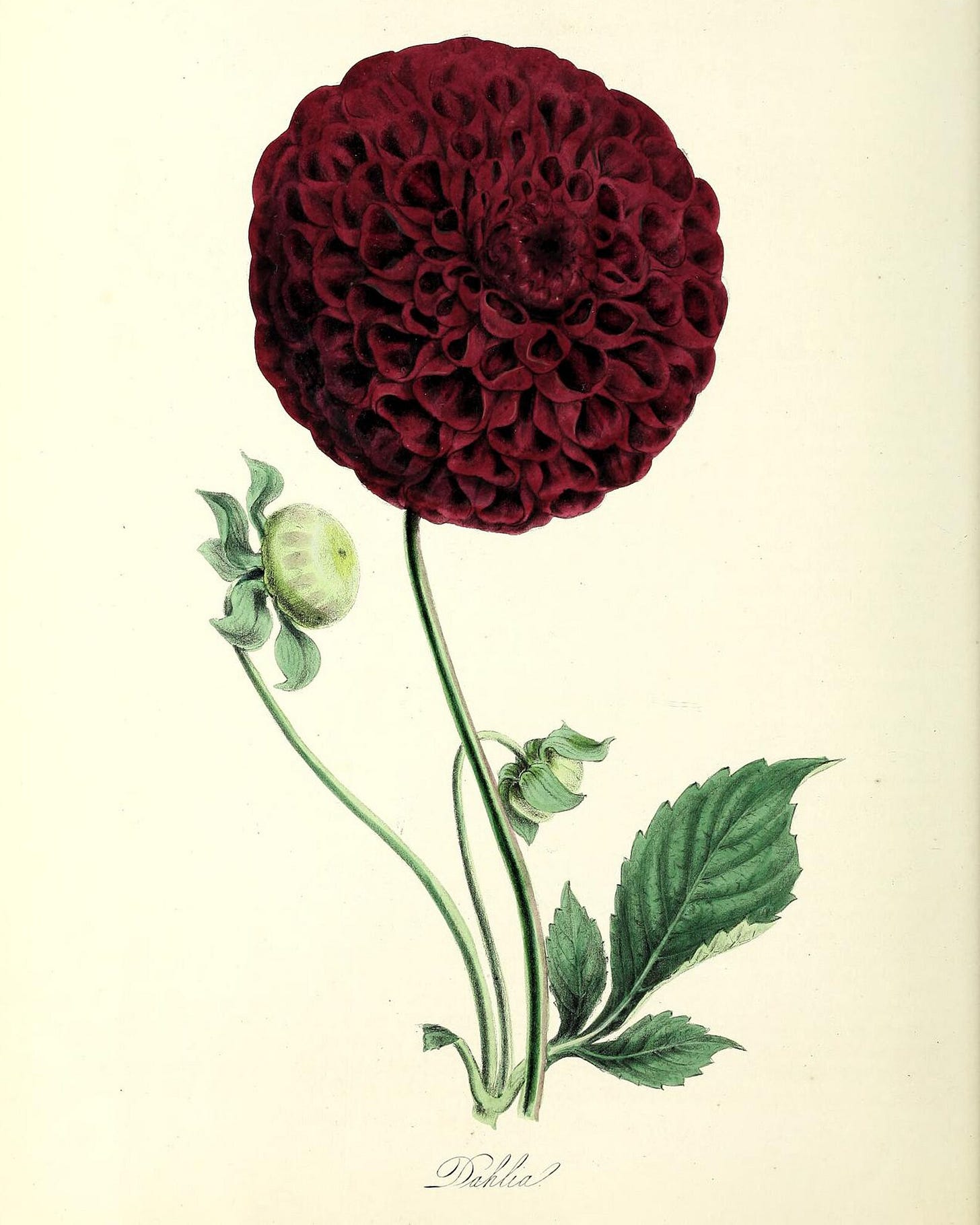

Oh I do love dahlias. We planted bulbs last autumn but they didn’t flower, which I believe is sometimes the case in the first year!
Always fascinated by your posts because you share so much detail and insight. Love the history, especially the transporting of water via the stems 😃💛
OHHHH yes I always think of them as a transitional flower, popping up from August! I never would have guessed that. I LOVE dahlias in that they are so generous with their varieties, but I resent their lack of scent. A beautiful piece, shared with such eloquence and I always adore your visuals xx